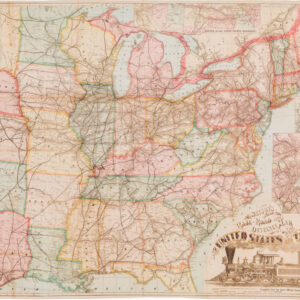Late 18th century North America atlas map with manuscript notations
General Map of North America, drawn from the best surveys, 1795
Out of stock
Description
Early atlas map of North America from the second atlas published in the United States, John Reid’s American Atlas (which accompanied William Winterbotham’s History of America).
Plotted on an equal-area projection, the original map displays the fifteen current states of the United States, with maunscript notations recording new states and territories. In terms of dating the notations, the fact that Ohio is listed as a state but Indiana as a territory suggests the notations were added between the incorporation of the two into the Union; that is, between March 1st, 1803, and December 11th, 1816. The original map was drawn before the Louisiana Purchase of 1803 and neither do any additions allude to it.
There is one other interesting notation — especially given the lack of western detail in the map itself — depicting and labeling the Columbia River sweeping down to the Pacific Ocean. English Royal Navy commander George Vancouver and American captain Robert Gray both separately explored the coast where the Columbia meets the Pacific at the end of the 18th century. The area was of keen interest due to speculation that the mouth of the Columbia represented the terminus of the fabled Northwest Passage. Some contemporary maps tried to link the Columbia with the Missouri River or across the North American Continent. These ideas began to be invalidated after the expeditions and maps of Lewis and Clark (1803-5). The Columbia on our map is more true to the actual course.
Other features of the original map include a large unnamed lake in drawn in the area of present-day Salt Lake City and an ill-defined border between Canada and New England.
Cartographer(s):
Condition Description
Scattered foxing; overall very good.
References





